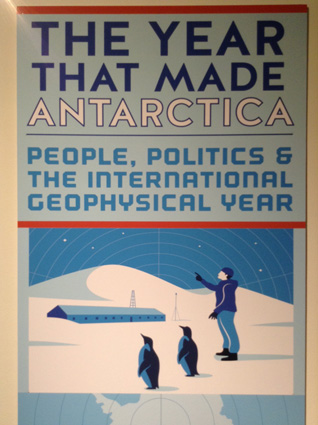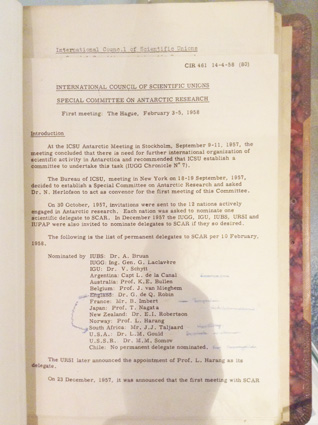 SCAR makes a small but significant appearance in the current special exhibition at the Scott Polar Research Institute’s Polar Museum. Named “The Year That Made Antarctica”, the exhibition is about the people and politics of the International Geophysical Year.
SCAR makes a small but significant appearance in the current special exhibition at the Scott Polar Research Institute’s Polar Museum. Named “The Year That Made Antarctica”, the exhibition is about the people and politics of the International Geophysical Year.
The world of the early 1950s was both optimistic and mistrustful. A peaceful Europe was rebuilding itself following the devastation of the Second World War, but interchange between East and West had been severely curtailed by the Cold War. It was in this climate that the International Geophysical Year or IGY (1957-58), was planned. It was the first major global year of science aimed at studying the earth system as a whole. The war had prompted significant advances in radar, rocket and computer technology and Stalin’s death in 1953 allowed for greater scientific collaboration across the Cold War divide.
 On display in the exhibition is SCAR’s Minute Book, open at the initial page to show the very first meeting of the Special Committee held in The Hague in February 1958. The Committee was established because “there is need for further international organization of scientific activity in Antarctica”.
On display in the exhibition is SCAR’s Minute Book, open at the initial page to show the very first meeting of the Special Committee held in The Hague in February 1958. The Committee was established because “there is need for further international organization of scientific activity in Antarctica”.
A major component of IGY was the study of Antarctica, a region that was still largely unknown up to that point. Planning for the Antarctic component of IGY had shown the need for a body to coordinate the scientific activity in Antarctica and so the Special Committee on Antarctic Research (SCAR) was formed, meeting for the first time in February 1958. But for scientific collaboration in Antarctica to be successful, it was also clear that an international agreement to preserve the region for peace and science was essential – hence the Antarctic Treaty came into being in 1959.
The exhibition looks at the major achievements of IGY through some of the people that made it happen. From the research bases established on the Antarctic continent to the surprise launch of Sputnik by the USSR, the exhibition shows the astonishing advances in knowledge and technology that were made during IGY. Mass observations were carried out on an unprecedented scale, and even amateurs were able to contribute by recording aurora sightings or tracking satellite signals. Rocks collected during IGY and sent for analysis to Dr Edna Plumstead in South Africa provided vital evidence in support of the theory of continental drift. The enduring legacy of IGY is shown through the establishment of World Data Centres and the founding of SCAR and the Antarctic Treaty.
SCAR Admin Assistant Rosemary Nash was a member of the group that curated the exhibition and Dr Peter Clarkson, former SCAR Executive Secretary and co-author of the SCAR history book Science in the Snow, spoke to the group about the beginnings of SCAR and the history of its relationship with the Treaty System.
The exhibition continues until 9 September.
For more information, read the article on The Guardian website written by Museum Curator Charlotte Connelly, “How Antarctica became home to a new kind of scientific diplomacy“.
